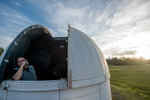
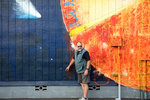
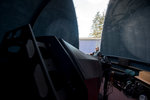
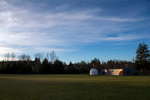
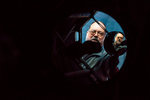
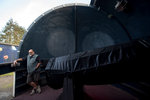
Johnny Garcia may be a small-town teacher, but he keeps his eyes on the world, and out of it too. For the past 23 years, Garcia has taught science at Onalaska High School, and for the majority of that time, he has also been the eager gatekeeper of the high-powered Herold Observatory, which is tucked neatly behind Onalaska Elementary School.
During an interview in January 2017, Garcia noted that any time he opens the Herold Observatory, even if it is for a class or a special group, the general public is invited to attend as well. The first few years, though, Garcia had nothing to do with the observatory outfit, but only because it did not exist. First, it took a big bang of inspiration from his inaugural students.
For his continued efforts in both earthbound and celestial sciences, Garcia was chosen to receive the 2016 Russ Mohney Recreation Resource Award. The award is presented each year by The Chronicle and the Lewis Economic Development Council to individuals or organizations that advocate for conservation of natural resources and enjoyment of the outdoors.
Garcia, 56, was raised in Albuquerque, New Mexico. He attended two years of college at the University of New Mexico before transferring to the University of Idaho in Moscow in order to finish up his bachelor’s degree. Eventually, he earned his master’s degree in teaching from The Evergreen State College. All the while, he was honing his love and understanding of natural sciences. Garcia even worked for the U.S. Forest Service for six years through college as part of its ecology team.
Having lived in Olympia since the early 1990s and worked at Onalaska High School since 1995, Garcia enjoys the rhythm of his world and has inertia firmly on his side.
“My goal is to be here, well, not until I die, but until I retire. I like the community here,” said Garcia, who noted that things started to fall into place for him in Onalaska right away. “When I got here in 1995, I was very fortunate to have this very nerdy class of kids, which isn’t always the case.”
Those “nerdy” kids were a part of Garcia’s after-school advanced science class. Each student was required to create and complete an independent project over the course of the year, and as fate would have it, one of those students wanted to write a grant for a telescope.
That’s when Garcia says Ed Oliphant, a familiar face and helping hand around big time Onalaska projects, came forward and said, “Why don’t we shoot for the stars. Let’s not just do a telescope. Let’s do an observatory.”
In order to save money and get the exact apparatus that they wanted, the original plans were drafted and the components built from scratch as the donations trickled in over the years. The labor of love was finally completed in about 2003 and named to honor two key contributors to its existence.
First, the observatory itself is called the Herold Observatory in honor of Ed Herold, who was of paramount importance to concerted fundraising efforts. Secondly, the telescope is known as the Turner Telescope. It is named after Mike Turner, who was the father of two of those students from Garcia’s first and formative class. Turner was also a machinist and donated close to 300 hours of his time to construct and assemble nearly every piece of the custom telescope that is still in use today.
“The fact that this is a custom telescope with unique abilities, I’ve been told it would be worth around $100,000,” said Garcia.
Instead, thanks to all of the donated time and effort from the community, the telescope was built for less than $30,000. Today, it is the largest telescope open to the general public in Western Washington.
“There’s no other telescope like this in the world because we’ve designed it so that little kids can look through it as well as people with disabilities,” explained Garcia. “I view myself as sort of a big cheerleader because I didn’t build this. That’s why it’s not called the Garcia Observatory.”
Garcia says that he often has people travel in excess of 30 miles in order to join a stargazing party in Onalaska. He says it’s a lack of exposure to the heavens and a natural sense of wonder that regularly draws folks in from so far away.
“Most people don’t think about astronomy that much,” said Garcia, who prides himself on providing perspective through the size and proportion of outer space.
One of his favorite guideposts is to use the distance from Interstate 5 to Onalaska, which is about 8 miles, to point out that if a person were to travel that relatively short distance straight up in the air they would most certainly die since only a handful of people have ever gone that far and come back to tell about it. These days, with the deaths of several accomplished astronauts, even those first-hand accounts are becoming more and more scarce.
“Just think about it. We’re just this little tiny planet and about 99 percent of people only ever think about this tiny planet. ... Previously you used to be able to control entire societies if you understood the night sky,” said Garcia. “Most of the time we have a hard enough time even looking around and paying attention to the things that surround us.”
Garcia says that the lessons gleaned through universal observation are applicable across the board here on our home planet. He finds it particularly useful to point out the limited abundance of perfectly calibrated natural elements that we have here on Earth as compared to other less hospitable locations.
On a more reactionary level, he says that viewing Saturn regularly elicits the most “oohs and aws” due to its spectacular planetary ring. He also enjoys showing off the perseid meteor showers for two weeks every August and has a particular affinity for the globular cluster of stars that make up the Hercules constellation.
“If you look at it with your naked eye it looks just like a smudge at best, but when you look at it through this you will see thousands of stars,” explained Garcia. “It’s one thing to look at a patch in a photo in a magazine that one or our powerful cameras has taken a picture of. It’s another thing to come out here and look at a spot that when I point at it it’s completely dark and then you look through this and see something that’s 25 million light years away. And you see it with your own eye.”
When the observatory first opened, it would draw about 100 people per showing. Garcia loved the enthusiasm but admits that the 30 or so people who typically show up for viewings these days is a much more manageable number that leads to a more enjoyable experience for all. During the summer meteor showers, folks are invited to bring tents along and camp out all night long in the field around the observatory.
“I think that the community takes a lot of pride in it,” said Garcia. ”Probably 30 percent of the people who show up here are from the community, but it actually draws people in, and that’s a big thing for a community like this.”
Garcia also coaches cross country at the high school and coordinates a science stream team as part of one of his classes. The stream team is tasked with keeping tabs on Carlisle Lake, also known as Old Mill Pond, by collecting water quality and temperature data from various strategic locations at, and leading into the the pond.
The data is compiled in an effort to develop an overall picture of the vitality of the long tortured body of water. He is also helping along plans to submit an application for a grant that would pay to create a demonstration aquaponic greenhouse, complete with solar panels that would go on display in front of the high school.
His hope is to create it on a small enough and practical enough scale that community members will want to, and be able to, copy it for themselves at home.
No matter what the specific task in front of him, Garcia takes pride in inspiring students, or citizens, to continue learning about the wide world that surrounds us all.
Garcia even began teaching observational astronomy at Centralia College in 1998 in order to broaden his reach. He still teaches the class today, largely as a built-in excuse to open up the observatory more often.
“I made a promise a long time ago that I would open this place up and I would do that as long as I can,” said Garcia, who noted that he’s often approached by groups such as home school parents and Boy Scouts asking if they can set up a time to see the stars from Onalaska. As long as the weather cooperates, he almost always says yes.
“Basically if there is an individual who wants me to open it up that gives me an opportunity to open it up to the community as well, because what people have to remember is that anytime it is open it is open to the public,” said Garcia.
Garcia says that in recent years he has typically opened the observatory about 20 to 30 times per year, although weather can have a significant impact on those opportunities.
“I just think it’s kind of eye inspiring,” said Garcia. “For some people it can make you feel small. To other people, it just makes you wonder.”
To learn more about the Herold Observatory or to check out the viewing calendar go online to https://sites.google.com/a/onysd.wednet.edu/observatory/, or if you have specific questions call 360-330-1745. The observatory is located just a short distance from Carlisle Avenue on the Onalaska School District campus.
The Russ Mohney Recreation Resource Stewardship award is meant to embody the spirit of Mohney, a self-described “backyard naturalist” who for decades entertained The Chronicle’s readers with his eloquent and insightful dispatches from the great outdoors.